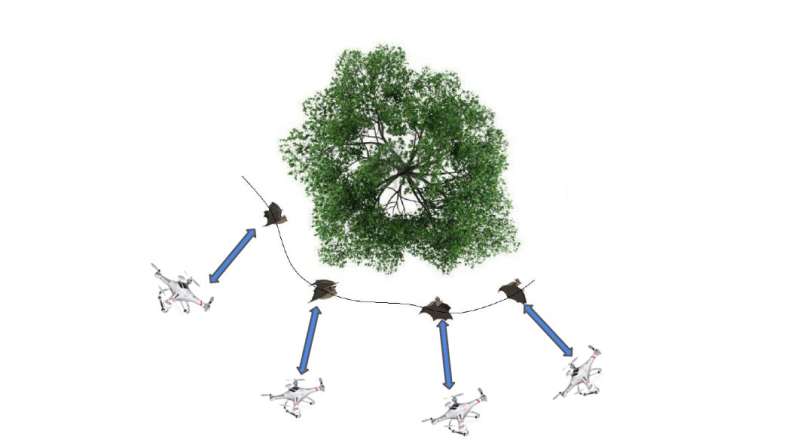March 3, 2020 feature
A simulation framework for recreating bat behavior in quad-rotor UAVs

In recent years, researchers worldwide have been trying to develop computational techniques that reproduce behaviors of humans or animals in robots and machines. This includes, for instance, the structure and functioning of the human brain, the swarm communication ability of bees, the locomotion styles of specific species of fishes or amphibians, and much more.
Building on the achievements of previous studies, researchers at Virginia Tech and the University of Maryland have recently introduced a simulation framework that could be used to recreate bat behavior in quad-rotor UAVs. This model, presented in a paper pre-published on arXiv, was born out of a collaboration between Rolf Müller, an expert in biosonar sensing, statisticians Xiaowei Wu and Hongxiao Zhu, and computer scientist Pratap Tokekar, funded by the National Science Foundation (NSF).
"Our general idea was to build UAVs that can recreate a bat's behavior while navigating complex, natural environments," Zhu told TechXplore. "In this particular study, our main objective was to build a computational framework to simulate the sensing environments of bats and produce simulated biosonar signals for training and testing purposes."
The simulation framework developed by Zhu and her colleagues consists of a model for simulating the geometry of random forests with trees and a model that generates biosonar signals. Biosonar signals are short sounds produced by bats and other animals, including whales and dolphins. These sounds generate echoes that contain valuable information about the surrounding environment, aiding animals in their navigation, as well as in their hunting and foraging efforts.
The new framework's first component is a model that provides detailed information about random environments. The second component mimics the biological mechanisms that enable biosonar-guided navigation in bats, producing simulated echoes that contain information about the robot's surroundings.
The simulation approach devised by Zhu and her colleagues has several unique features and advantages. One of the most remarkable is that it allows random simulations to run repeatedly, thus it can produce rich sensory data that would be harder to gather using more traditional experimental approaches.
"The main successes of robotics so far have been in constrained, structured environments such as warehouses and industrial settings," Tokekar, co-investigator of the study, told TechXplore. "There is a lot of interest in using UAVs in unstructured environments such as forests and densely vegetated areas. Just to name two examples: DARPA recently concluded their Fast, Lightweight, Autonomy program, where, as the same suggests, the emphasis was on agile UAVs operating in forested environments, while the Army Research Lab announced a new program called SARA with a very similar goal in mind."
According to Tokekar, nature offers countless examples of behaviors that, if artificially replicated, could be extremely useful in robotics applications. The biosonar-assisted navigation abilities observed in bats, which their study focuses on, could specifically help to enhance navigation and object detection in flying robots.
In the future, the simulation platform developed by Zhu, Tokekar and their colleagues could be used to replicate this particular bat behavior in autonomous quad-rotor UAVs. In addition, it could help researchers to evaluate and compare different bat-inspired navigation algorithms within simulated environments.
"The most meaningful aspect of our work is that it provides a convenient platform for the training and testing of bio-inspired robotic algorithms for UAVs," Zhu said. "In our next studies, we plan to train and test robotic algorithms for different navigation tasks by using the Biosonar data generated in this framework."
More information: Recreating bat behavior on quad-rotor UAVs- a simulation approach. arXiv:2002.05060 [cs.RO]. arxiv.org/abs/2002.05060
© 2020 Science X Network





















